Media | Articles
Your handy (1990-97) Mazda Miata buyer’s guide
It’s kind of hard to believe today, when Mazda struggles to sell 10,000 Miatas annually, but there was a time when Mazda’s beloved roadster landed in more than 25,000 driveways each year. If you were paying any attention at all in 1989 and 1990, the NA (first-generation) Miata seemingly came out of nowhere, and suddenly it was everywhere you looked. Known globally as the MX-5, the Miata reinvented a vehicle segment in ways that its contemporaries like the Toyota MR2, the Australian Mercury Capri, and even the Pontiac Fiero never could. And, perhaps more importantly, it thrived.
Model overview
1990
After its debut at the Chicago Auto Show on February 10, 1989, the NA Miata went on sale in the United States in May as a 1990 model year. Sporting an all-steel monocoque with an aluminum hood, the Miata’s design was a collaborative effort by Mazda’s Tom Matano, C. Mark Jordan and Masao Yagi, at the behest of Bob Hall, a former journalist who secured a position at Mazda based on his sketches of a two-seat sports car.
The 1990 Miata was equipped with a BP-ZE 1.6-liter, normally aspirated four-cylinder derived from the Mazda 323, but capped with a unique cast aluminum cam cover. The only available transmission was a five-speed manual (sourced from the home market 929) and a 4.30:1 differential fed power to the Miata’s rear wheels. While an open differential was standard fare, a viscous limited-slip differential was optional.

The Miata was available in one trim level for 1990, but with two significant option packages; Package A included power steering, a leather-wrapped steering wheel, alloy wheels, and an AM/FM cassette player. Package B included everything in Package A, plus cruise control, power windows, and headrest speakers.
There were also a handful of standalone options for the first year: the aforementioned limited-slip rear diff, a removable hard top with a glass back window (finished in red only), air conditioning, and a CD player (which required either the A or B Pack).
Marketplace
Buy and sell classics with confidence
Three exterior colors were available initially: Classic Red, Crystal White, and Mariner Blue (informally known as “Superman Blue.”) Later in the 1990 model year, Mazda introduced Silver Stone Metallic, a color that’s sought out by enthusiasts.
1991
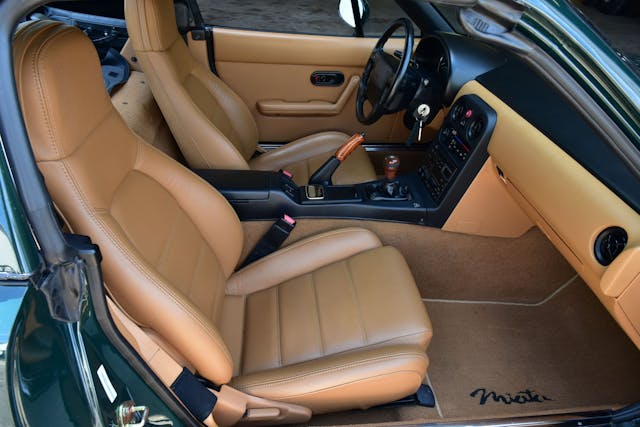
The second model year brought a handful of minor changes. Months into the 1991 model year brought a change to the crankshaft nose, which eliminated a fair bit of stress when it came time to change the Miata’s timing belt. (More on that later.)
The biggest revision was to the option list, as a four-speed automatic transmission (which precluded ordering the limited-slip differential), and anti-lock brakes were made available. If a Miata has ABS, it also has the B Package. The hardtop was also available in a wider range of colors (except for you, Silver Stone metallic).
The 1991 brochure introduces the Miata’s first Special Edition (SE), sporting a British Racing Green exterior with a tan leather interior. This was the first time leather was available. While the SE is referenced in the Miata brochure, it also had a unique four-page pamphlet. The SE was a full B-package car, plus air conditioning, cruise and a CD player. The SE also included a Nardi wood shift knob, wood parking brake handle, and a tan tonneau cover, though some suggest the tonneau was also shipped in black. The only options were ABS, the hardtop and the automatic transmission. Just 4000 SEs were built.
1992
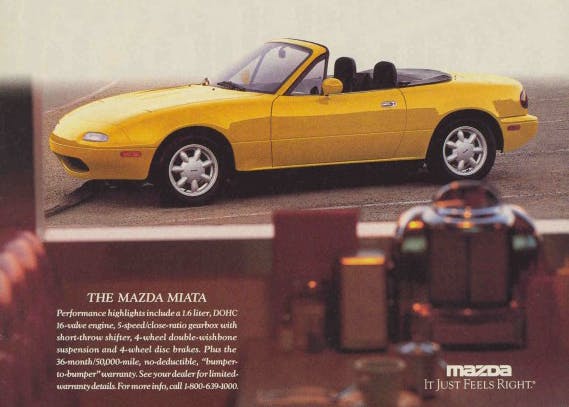
For 1992, all Miatas received a rear suspension cross brace for additional rigidity. There were two new colors, Brilliant Black and Sunburst Yellow, that latter of which came at a $250 upcharge. Despite not being a Special Edition, Sunburst Yellow Miatas (all A Packages) were indeed special, as they are a one-year-only color that’s now desired by collectors. Just 1519 Miatas were sprayed Sunburst Yellow, far fewer than the actual “Black Miata” special edition (4626) which was finished in Brilliant Black with a tan top and tan leather guts.
Unlike the fully loaded 1991 Special Edition, the Black Miata started as an A Package car. That included power steering, leather steering wheel, alloy wheels, AM/FM cassette stereo, and buyers could layer on the new, Black Miata-only C Package, with the Nardi wood shift knob and hand brake handle, stainless sill plates, BBS 14-inch alloy wheels, plus all the B-package contents including cruise control, headrest speakers, and a new power antenna.
1993

An all-new chrome emblem was added to the Miata and all Mazda products for 1993. The emblem (mounted on the Miata’s nose) depicted a smooth diamond with a hole in it (that hopefully doesn’t look too much like Renault’s logo) and Mazda was so keen to the design it also replaced the traditional block “MAZDA” script on the alloy wheel’s center caps.
There were no huge mechanical changes for 1993, but the option packages shifted around quite a bit. The A Package now included new power mirrors. B Package cars now had the power antenna from last year’s C Package. For 1993, the C Package included all the B Package material, plus a tan top and tan leather seating surfaces. Those tan bits are likely why the C Package was unavailable on Miatas painted Mariner Blue. The only change to the option list was a new Mazda Sensory Sound System, which added a silver-faced cassette/CD Player, digital sound processing, two full range door speakers, two sill-mounted tweeters, four headrest speakers and two seatback-mounted bass transducers. This extensive audio upgrade required the B or C Package.
The special edition for 1993 was no longer “special.” Now called a Limited Edition, this Miata had a black exterior with a brilliant red leather interior, and a tonneau cover with a black top. Mazda built just 1,500 numbered Limited Editions and threw everything they could at them: Nardi leather shift knob, 14-inch BBS alloy wheels, Mazda Sensory Sound System, stainless sill plates, Sport Suspension (Bilstein shocks and revised springs), rear spoiler, front air dam, rear skirt, air conditioning, ABS, limited-slip differential, and everything from the A and B Packages.
1994

1994 was a big year, including the first major mechanical change since 1991’s automatic gearbox. The 1.6-liter gave way to a 1.8-liter four-cylinder, offering a boost of about 15 horsepower. Along with a number of mechanical changes to allow for the jump in horsepower, the rear differential “grew” slightly taller, increasing to a 4.10:1 ratio from 4:30:1. Additional chassis bracing improved torsional rigidity yet again.
Along with the improved engine came a host of smaller revisions, including larger brakes and newly designed alloy wheels. The optional differential also got a major change: The viscous limited-slip departed and in its place was a new Torsen limited-slip, a prized option by anyone interested in racing the Spec Miata series. All A Package cars were equipped with the Torsen. For 1994, Mariner Blue bowed out and was replaced with Laguna Blue Metallic.
The contents of the A, B, and C Packages stayed the same other than the Torsen, but there was an all-new addition: The R Package. The R included a Sport Suspension with Bilstein shocks, a rear spoiler, a front air dam, a rear skirt, aluminum wheels and the Torsen. You couldn’t buy an R Package with power steering, or the B or C Packages. At $1500, the R Package wasn’t cheap. It also replaced a Special or Limited Edition that year, and only 1218 were made.
1994 also marked the debut of the M Edition, this year in Montego Blue Mica, with tan leather, a tan top boot and tan top. Inside the M Edition included a Nardi wood shift knob and hand brake handle, polished alloy wheels, air conditioning, stainless sill plates, custom mats, M Edition key ring, badge and lapel pin, along with all equipment found in the A and B Packages.
1995
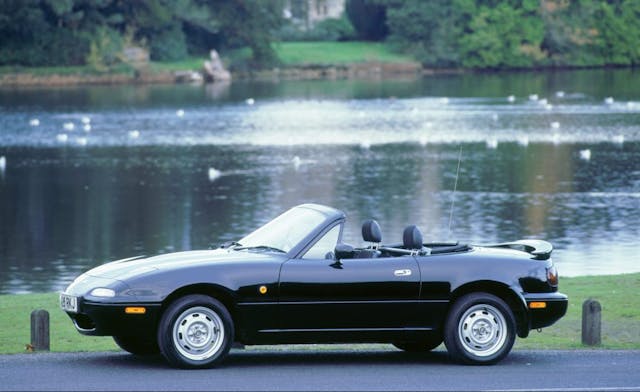
There was a reshuffling of packages again this year, as the Miata’s lettered packages disappeared. Replacing the A Package was the more robust Popular Equipment Package (PEP) that included power steering, leather wrapped wheel, power mirrors, alloy wheels, the Torsen differential (manual cars only), headrest speakers, cruise control, power windows, and a power antenna. The only other option package was the Leather Package, which included all the gear from the PEP, plus tan leather seating surfaces and a tan top. The Mazda Sensory Sound System was optional on the Leather Package.
The M Edition was the big news, though. Painted in a bespoke color (Merlot Mica), the M Edition included all PEP equipment and added a tan leather interior, a tan boot, leather Nardi shift knob, 15-inch BBS wheels with high-performance tires, cut pile carpeting, stainless sill plates, air conditioning, a CD player and four speakers, and ABS. The M Edition also had unique floor mats, a unique exterior badge, an M Edition key ring, and lapel pin. Launched at the 1995 Chicago Auto Show, the M Edition was only available for six months, and only 3500 were built.
The R Package still existed in 1995, and just 465 were built. There was also a single new color for 1995, Montego Blue Mica, which debuted on the 1994 M Edition, but was now available across the board.
1996

For 1996, the Miata was OBD-II compliant in keeping with federal regulations. The 1.8-liter four also got a boost to 133 hp, while the interior received a number of minor comfort and convenience updates.
The M Edition was (subjectively) one of the prettiest, finished in a Starlight Mica paint scheme, with tan leather seating surfaces, and a matching boot and top. It also included the Nardi wood shift knob and parking brake handle, 15-inch Enkei five-spoke wheels with high-performance tires, M Edition floor mats, a blue Miata logo on the seat backs, stainless sill door plates, ABS, air conditioning, Mazda Sensory Sound System, an M edition logo on tachometer, an exterior M Edition badge, M Edition key fob, badge, and lapel pin, custom floor mats, a security system and remote entry. It also received everything from the Popular Equipment Package.
According to the brochure, the M Edition was limited production, but Mazda sure made a lot of them; 2968 in total. The R Package was also available, but limited to only 111 units. Colors for non-special editions were limited to Classic Red, Brilliant Black, White, and Montego Blue Mica.
1997
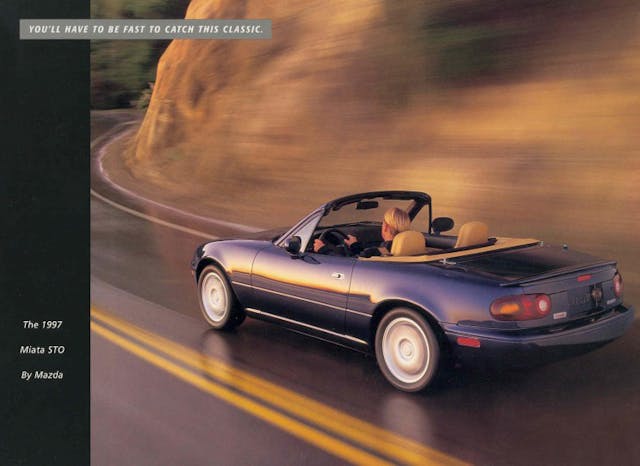
The final year for the NA Miata ushered in another shakeup in the option packaging department. For 1997, you could order a Miata with:
- The Power Steering package, which included power steering and trim rings on the base steel wheels.
- The Touring Package, which stripped a lot of equipment from the previous year’s Popular Equipment Package, including power steering, leather wheel, power windows, power mirrors, and alloy wheels, and added door map pockets.
- The Popular Equipment Package, containing the Touring Package, plus the Torsen diff, additional subframe bracing, headrest speakers, cruise and a power antenna.
- The Leather Package and R Package were available and essentially unchanged.
If you’re into rarity, Mazda only built 47 R Packages in 1997, the lowest production of any Mazda package. This was also the only year for the Special Touring Option (STO), but Mazda advertised it as “Still the One.” No matter what you called it, the STO was painted Twilight Blue Mica with a tan top, boot and leather interior, along with a leather Nardi shift knob, 15-inch Enkei five-spoke wheels, stainless door sill plates, rear lip spoiler, rear subframe brace, CD player with headrest speakers, custom floor mats with the STO label, power steering, leather-wrapped steering wheel, power mirrors, power windows, a Certificate of Authenticity, and a numbered STO dash plate. STOs were nicely loaded, but you could not option it with cruise control, ABS, Torsen differential, Mazda Sensory Sound System, electric antenna, or the factory hardtop. Just 1500 STOs were produced.
Before you buy
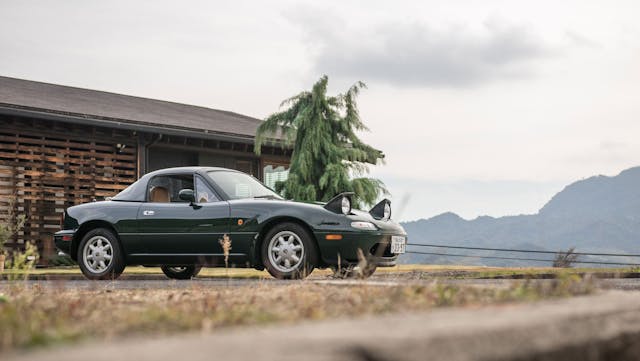
In general, the Miata is a rock-solid sports car, even when daily driven through all kinds of weather. But there are a handful of things to look out for. The 1.6-liter engines are great and generally maintenance-light workhorses that can easily travel into the 200,000 mile range without breaking a sweat. However, 1.6-liter engines that came in the 1990 and early 1991 model years had a short-nose crankshaft, which didn’t reveal itself as a problem until a timing belt change was required.
The early 1.6’s timing belt procedure included replacing the crankshaft seal, and that’s where the trouble starts. Improper reassembly of the crank pulley key in the keyway can cause the pulley bolt to fail, and eventually, the entire crank replacement. This occurred for about 1 percent of all 1990 and early 1991 Miata owners. Now, timing belt maintenance usually skips the crank seal unless it’s leaking, which avoids the problem altogether, but it’s still critical if you’ve got a 1990 or early 1991 that you have the timing belt replaced by someone who knows what they’re doing.
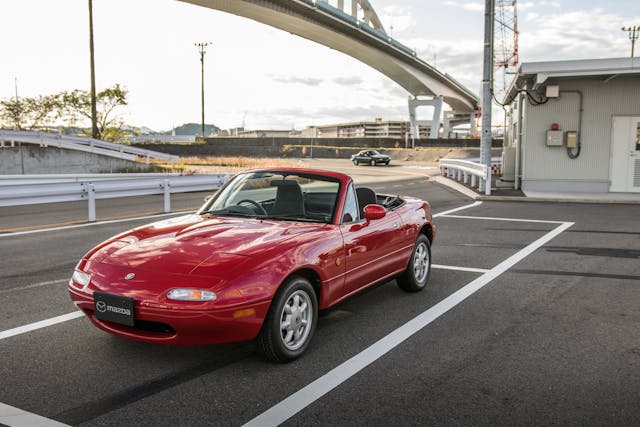
The aforementioned limited-slip differential is a desirable option for owners interested in maximum handling prowess, so checking for its presence and functionality is recommended. Beyond jacking the car up and spinning a rear wheel to see which direction the opposite wheel turns, you can tell if your potential purchase has an original viscous limited-slip by the ears on the left side of the case, around the stub flange. If they’re different than the ears on the right side of the case, it’s a viscous limited-slip. If they’re the same, it’s an open differential. Later-model Miatas with optional Torsen differentials have a four pronged “clover” attached to the pinion, this is a vibration damper not used in the open differential.
Rust is the next big concern. Mazda did a decent job installing drains in the body, but they’d become plugged about six days after the cars rolled out of the showroom, causing water to back up inside the car. This leads to everything from smelly carpets to rusty, blown-out floors. Miata rocker panels are notorious for rust, most notably ahead of the rear wheel arches, but this can be repaired by a decent body shop.

Inside, examples with cloth seating can look worn within the first five years, especially near the driver’s bolster. Original headrest speakers are likely blown out by now, but aftermarket replacements are often superior to the OEM speakers. If you have the original audio system in an early Miata, you’ll need to learn how the code works in case the battery ever dies. (Instructions for resetting it are available online.) These cars also had—and still have —a thriving aftermarket community, so if you’re all about originality, finding a source for things like shift knobs, steering wheels, wheels, air boxes and other factory parts may be needed. A lot of these bits ended up in the garbage when these cars were newer, done so in pursuit of personalization and customization.
Unlike most other cars, the Miata has a perhaps equal number of enthusiasts who are interested in racing. All NA Miatas are potential spec racer candidates, but some are better suited to the task than others. The general consensus is to buy a big-nose crank car (late 1991 to 1995) and focus on 1994 models because of these features: 1.8-liter engine, additional bracing, larger brakes, a mechanical oil pressure gauge, and the Torsen differential. That said, any NA Miata is a phone call away from having a limited-slip differential, so given the choice between a clean, unmolested late 1991 and a ratty 1994, pick the 1991.
Valuation
You’ll want to check the Hagerty Valuation Tool for the most recent Miata values, because after at least a decade of price stability, these cars are on the move. Early base Miatas with steel wheels, a bit of mileage, and sprayed in the conventional colors are still available in the $6000 to $7000 range for #3-condition (Good) cars. Later cars with the 1.8 are much more expensive, especially when you get into the Special Editions. At any major auction, a 1995 M Edition with around 50,000 miles is easily good for $12,500.

These cars were ripe for engine swaps, turbos, and superchargers, and surprisingly, these modified cars sell for good money. LS-swapped Miatas sell for ridiculous prices, possibly because of the Shelby Cobra’s halo effect. Cars with their original engines that sell at the top of the price ladder are almost universally the Special Edition cars, with mileage under 10,000. Notable sales include a 14,000-mile original 1991—one of just 4000 in that year’s Special Edition color—sold for $31,500; a 6700 mile 1992 B-Package car with a matching hardtop for $21,263; and an 8000-mile 1993 Limited Edition which sold for $36,750.
The folks interested in these cars should be no surprise: Gen X, which makes up 30 percent of the classic car market, represents about 19 percent of the insurance quotes processed by Hagerty. Millennials—who spent their youth paying attention to Miatas when they were new—only represent 18 percent of the classic car market, but make up 22 percent of the quotes for these cars. Boomers make up 40 percent of the market versus 34 percent of the Miata quotes we process. Pre-Boomers and Gen Y make up seven and five percent of the classic car market, respectively, but Pre-Boomers only made up eight percent of the quote requests. Gen Y more than doubled that at 17 percent.
Regardless of the recent uptick in values, though, the NA Miata is still the egalitarian sports car it always was. They’re a blast to drive, an easy introduction into racing, and they take up little space in the garage. Everybody should own at least one example at some point. For many the NA Miata’s affordable, reliable, great-looking recipe for fun still has yet to be improved upon.




















Recently moved to NC Have a 1990 Miata in need of new top. Rear window split as it’s plastic. Would love info on any Miata clubs or meet and greet in the Smithfield area
I have a 1990 Mazda Miata red automatic, with rollbars for sale to a collector only